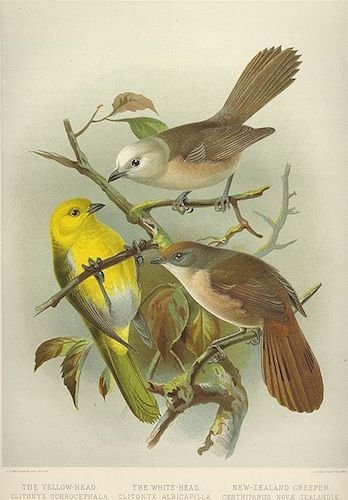Mohouidae – Whitehead, Yellowhead & Brown Creeper

Mohoua is a small genus of three bird species endemic to New Zealand. The scientific name is taken from either mohuahua or momohua – both Māori names for the Yellowhead. Their taxonomic placement has presented problems: They have typically been placed in the Pachycephalidae family (whistlers), but in 2013 it was established that they are best placed in their own family, Mohouidae.
All three species display some degree of sexual dimorphism in terms of size, with the males being the larger of the two sexes.
Mohoua are gregarious (more so outside the breeding season) and usually forage in groups. They also forage in mixed species flocks at times, frequently forming the nucleus of such flocks. Social organization and behaviour is well documented for all three Mohoua species; cooperative breeding has been observed in all three species and is common in the Whitehead and Yellowhead.
The three species of this genus are the sole hosts for the Long-tailed Cuckoo which acts as a brood parasite upon them, pushing their eggs out of the nest and laying a single one of its own in their place so that they take no part in incubation of their eggs or in raising their young
The three species are:
Whitehead Mohoua albicilla
Yellowhead Mohoua ochrocephala
Brown Creeper (Pipipi) Mohoua novaseelandiae.
-
Number of bird species: 3
-
Brown Creeper Mohoua novaseelandiae
Species AccountBrown creepers are found in a wide range of forested and shrubland habitats throughout the South Island and Stewart Island. Often the first sign is a large chattering flock high in the forest canopy. -
Brown Creeper Mohoua novaseelandiae
Species AccountSpecies InformationBreeding and ecologyBrown creepers are found in a wide range of forested and shrubland habitats throughout the South Island and Stewart Island. Often the first sign is a large chattering flock high in the forest canopy. The contact call is a distinctive harsh chatter. They can be attracted down by squeaking or pishing, but do not stay long as the flock moves on through the canopy. Once sighted the grey face and buff underparts are distinctive, contrasting with the darker wing feathers and brown crown and back. -
Brown Creeper Mohoua novaseelandiae
IUCN Species StatusThe global population size has not been quantified, but the species is described as locally common and widespread (del Hoyo et al. 2007). -
Brown Creeper Mohoua novaseelandiae
Species AccountSound archive and distribution map. -
Brown Creeper Mohoua novaseelandiae
Species AccountThe pipipi (Mohoua novaeseelandiae), also known as brown creeper or New Zealand creeper, is a small passerine bird endemic to the South Island of New Zealand. They are specialist insectivores, gleaning insects from branches and leaves. They have strong legs and toes for hanging upside down while feeding. -
Whitehead Mohoua albicilla
IUCN Species StatusThe global population size has not been quantified, but the species is described as common on Kapiti and Little Barrier islands and moderately common in forested areas of the north island of New Zealand (del Hoyo et al. 2007). -
Whitehead Mohoua albicilla
Species Account -
Whitehead Mohoua albicilla
Species AccountSound archive and distribution map. -
Whitehead Mohoua albicilla
Species AccountThe whitehead (Mohoua albicilla) or pōpokotea is a small species ( 15 cm in length, 18.5/14.5 g.[2]) of passerine bird endemic to New Zealand. It is currently classified in the family Mohouidae. -
Yellowhead Mohoua ochrocephala
IUCN Species StatusThis species is listed as Endangered because its very small population has recently undergone very rapid population declines following stoat and rat irruptions, and some subpopulations have been extirpated. -
Yellowhead Mohoua ochrocephala
Species AccountSound archive and distribution map. -
Yellowhead Mohoua ochrocephala
Species Accounthe yellowhead or mōhua (Mohoua ochrocephala) is a small insectivorous, passerine bird endemic to the South Island of New Zealand. Recent classification places this species and its close relative, the Whitehead, in the family Mohouidae.
